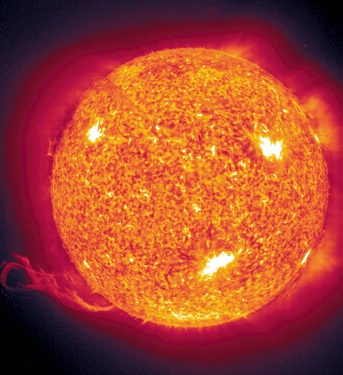ultraviolet astronomy
 study of the ultraviolet spectra of astronomical objects. ultraviolet radiation comes from a hotter region of the electromagnetic spectrum than visible light. For example, interstellar gas at temperatures close to 1,000,000 kelvins is quite prominent in the ultraviolet. It has yielded much important information about chemical abundances and processes in the Sun and certain other stellar objects, such as white dwarfs (white dwarf star).
study of the ultraviolet spectra of astronomical objects. ultraviolet radiation comes from a hotter region of the electromagnetic spectrum than visible light. For example, interstellar gas at temperatures close to 1,000,000 kelvins is quite prominent in the ultraviolet. It has yielded much important information about chemical abundances and processes in the Sun and certain other stellar objects, such as white dwarfs (white dwarf star).Ultraviolet astronomy became feasible with the advent of rockets (rocket) capable of carrying instruments above Earth's (Earth) atmosphere, which absorbs most electromagnetic radiation of ultraviolet wavelengths (i.e., roughly 100 to 4,000 angstroms) from celestial sources. Much radiation is lost even at the highest altitudes that balloons can reach. During the 1920s, unsuccessful attempts were made to photograph the Sun's ultraviolet spectrum from balloons; not until 1946 did a rocket-borne camera succeed in doing so.
Since the early 1960s the United States and several other countries have placed in Earth orbit unmanned satellite observatories (satellite observatory) carrying telescopes (telescope) with optical surfaces specially coated for high ultraviolet reflectivity. These include eight Orbiting Solar Observatories, launched from 1962 to 1975 by the U.S. National Aeronautics and Space Administration (NASA), which enabled astronomers to obtain thousands of ultraviolet spectra of the Sun's corona. Another series of U.S. satellites, known as Orbiting Astronomical Observatories (Orbiting Astronomical Observatory), in service from 1968 to 1981, permitted the study of the interstellar medium and remote stars (star) in the spectral range of 1,200 to 4,000 angstroms.
 A telescope carried aboard the International Ultraviolet Explorer spacecraft (launched in 1978 by the European Space Agency 【ESA】, NASA, and the United Kingdom) allowed significant ultraviolet observations to be made of objects such as comets (comet) and quasars (quasar). The high-resolution Hubble Space Telescope, deployed in 1990, also collected ultraviolet-wavelength data about faint objects such as nebulae (nebula) and distant star clusters (star cluster). NASA's Extreme Ultraviolet Explorer (EUVE) satellite was launched in 1992 and studied stellar evolution and the interstellar medium. EUVE was succeeded in 1999 by NASA's Far Ultraviolet Spectroscopic Explorer (FUSE), which discovered molecular nitrogen in interstellar space. Another NASA ultraviolet satellite, the Galaxy Evolution Explorer (GALEX), was launched in 1993 and studied how galaxies (galaxy) change over billions of years. The Solar and Heliospheric Observatory (SOHO), an ESA-NASA satellite launched in 1995, has studied the Sun and its hot corona in ultraviolet light.
A telescope carried aboard the International Ultraviolet Explorer spacecraft (launched in 1978 by the European Space Agency 【ESA】, NASA, and the United Kingdom) allowed significant ultraviolet observations to be made of objects such as comets (comet) and quasars (quasar). The high-resolution Hubble Space Telescope, deployed in 1990, also collected ultraviolet-wavelength data about faint objects such as nebulae (nebula) and distant star clusters (star cluster). NASA's Extreme Ultraviolet Explorer (EUVE) satellite was launched in 1992 and studied stellar evolution and the interstellar medium. EUVE was succeeded in 1999 by NASA's Far Ultraviolet Spectroscopic Explorer (FUSE), which discovered molecular nitrogen in interstellar space. Another NASA ultraviolet satellite, the Galaxy Evolution Explorer (GALEX), was launched in 1993 and studied how galaxies (galaxy) change over billions of years. The Solar and Heliospheric Observatory (SOHO), an ESA-NASA satellite launched in 1995, has studied the Sun and its hot corona in ultraviolet light.- World War II
- World War II Casualties, Table
- Worldwide Adherents of All Religions by Seven Continental Areas, Mid-1994
- Worldwide Adherents of All Religions by Six Continental Areas, Mid-1995
- Worldwide Adherents of All Religions by Six Continental Areas, Mid-1996
- Worldwide Adherents of All Religions by Six Continental Areas, Mid-1997
- Worldwide Adherents of All Religions by Six Continental Areas, Mid-2001
- Worldwide Adherents of All Religions by Six Continental Areas, Mid-2002
- Worldwide Adherents of All Religions by Six Continental Areas, Mid-2003
- Worldwide Adherents of All Religions by Six Continental Areas, Mid-2007
- Worldwide Adherents of All Religions by Six Continental Areas, Mid-2008
- Worldwide Adherents of All Religions, Mid-2004
- Worldwide Adherents of All Religions, Mid-2005
- Worldwide Adherents of All Religions, Mid-2006
- Worldwide Church of God
- Worldwide dose commitment from radioactive fallout from nuclear tests prior to 1970
- World Wide Web
- worm
- Wormley Conference
- Worms
- Worms, Concordat of
- worm shell
- worm snake
- Gujarat Plains
- Gujarāt